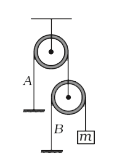A kit is 120m high and 130 m of string is out. If the kite is moving away horizontally at the rate of 52 m/sec, find the rate at which the string is being paid out.
To solve the problem of finding the rate at which the string is being paid out when a kite is flying at a height of 120 meters and moving horizontally at a rate of 52 m/sec, we can use the Pythagorean theorem and differentiation. Here’s a step-by-step solution:
Step 1: Understand the Problem
We have a kite flying at a height of 120 meters, and the length of the string (hypotenuse) is 130 meters. The kite is moving horizontally away from the point directly below it at a rate of 52 m/sec. We need to find the rate at which the string is being paid out (the rate of change of the string length).
Step 2: Set Up the Relationship
Let:
- h=120 m (height of the kite)
- x = horizontal distance from the point directly below the kite
- y = length of the string
According to the Pythagorean theorem:
y2=h2+x2
Substituting the known height:
y2=1202+x2
Step 3: Differentiate with Respect to Time
Differentiating both sides with respect to time t:
ddt(y2)=ddt(1202+x2)
This gives:
2ydydt=2xdxdt
Step 4: Substitute Known Values
We know:
- y=130 m (length of the string)
- h=120 m (height of the kite)
- dxdt=52 m/sec (horizontal speed of the kite)
First, we need to find x when y=130:
1302=1202+x2
Calculating:
16900=14400+x2
x2=2500⟹x=50 m
Now, substituting y, x, and dxdt into the differentiated equation:
2(130)dydt=2(50)(52)
Step 5: Solve for dydt
Simplifying the equation:
260dydt=5200
dydt=5200260=20 m/sec
Final Answer
The rate at which the string is being paid out is 20 m/sec.
---
We have a kite flying at a height of 120 meters, and the length of the string (hypotenuse) is 130 meters. The kite is moving horizontally away from the point directly below it at a rate of 52 m/sec. We need to find the rate at which the string is being paid out (the rate of change of the string length).
Let:
- h=120 m (height of the kite)
- x = horizontal distance from the point directly below the kite
- y = length of the string
y2=h2+x2
Substituting the known height:
y2=1202+x2
Differentiating both sides with respect to time t:
ddt(y2)=ddt(1202+x2)
This gives:
2ydydt=2xdxdt
We know:
- y=130 m (length of the string)
- h=120 m (height of the kite)
- dxdt=52 m/sec (horizontal speed of the kite)
1302=1202+x2
Calculating:
16900=14400+x2
x2=2500⟹x=50 m
2(130)dydt=2(50)(52)
Simplifying the equation:
260dydt=5200
dydt=5200260=20 m/sec
The rate at which the string is being paid out is 20 m/sec.
Topper's Solved these Questions
Similar Questions
A kite is 120m high and 130 m of string is out. If the kite is moving away horizontally at the rate of 52 m/sec, find the rate at which the string is being paid out.
View SolutionA kite is 300 m high and there are 500 m of cord out. If the wind moves the kite horizontally at the rate of5kmhrdirectly away from the person who is flying it, find the rate at which the cord is being paid?
View SolutionA ladder 13 m long is leaning against a wall. The bottom of the ladder is pulled along the ground away from the wall at the rate of 4 m/sec. Find the rate of decreasing at which the top of the ladder moving downwards on wall when the foot of the ladder is 5 m away from the wall.
View SolutionA mass is tied to a, string 1 m long and rotated in a horizontal circle at the rate of 600 rpm. If the tension inthe string is 3943.8 N, calculate the mass.
View SolutionThe block of mass m is at rest. Find the tension in the string A .

View SolutionA kite is moving horizontally at the height of 151.5 meters. If the speed of kite is 10 m/sec, how fast is the string being let out; when the kite is 250m away from the boy who is flying the kiet? The height of the boy is 1.5 m.
View SolutionA kite is moving horizontally at a height of 151.5m. If the speed of the kite is 10ms, how fast is the string being let out, when the kite is 250 m away from the boy who is flying the kite? The height of the boy is 1.5 m. (A) 8 m/s (B) 12 m/s (C) 16 m/s (D) 19 m/s
View SolutionA kite is moving horizontally at a height of 151.5m. If the speed of the kite is 10ms, how fast is the string being let out, when the kite is 250 m away from the boy who is flying the kite? The height of the boy is 1.5 m. (A) 8 m/s (B) 12 m/s (C) 16 m/s (D) 19 m/s
View SolutionA man is moving away from a tower 41.6 m high at the rate of 2 m/sec. Find the rate at which the angle of elevation of the top of tower is changing, when he is at a distance of 30m from the foot of the tower. Assume that the eye level of the man is 1.6m from the ground.
View SolutionA man is moving away from a tower 41.6 m high at the rate of 2 m/sec. Find the rate at which the angle of elevation of the top of tower is changing, when he is at a distance of 30m from the foot of the tower. Assume that the eye level of the man is 1.6m from the ground.
View Solution
